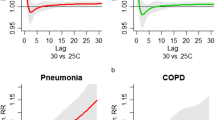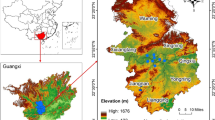Abstract
Aim
Meteorological factors play a role in respiratory and cardiovascular diseases. However, previous studies demonstrated inconsistent results regarding their associations. This paper aims to evaluate their relationships to facilitate anticipatory care for patients with respiratory and cardiovascular diseases.
Subject and methods
A retrospective time-series study, controlling for air pollution, was adopted to examine the effects of various meteorological factors on emergency hospital admission for chronic respiratory and cardiovascular diseases from 2007 to 2010 in a Hong Kong hospital. Impact of weather was examined up to 3 weeks to account for the possible delayed effects of meteorological factors.
Results
Barometric pressure was positively associated with hospital admission in a linear fashion, while temperature demonstrated a linear negative association. Delayed effects of air pressure were noted up to lag weeks 2 and 3 for cardiovascular and respiratory admission respectively. Temperature also showed a progressive reduction in lag effects on respiratory and cardiovascular diseases admission up to lag week 3. Relative humidity, global solar radiation and wind speed demonstrated no significant associations with hospital admission.
Conclusion
Anticipatory care to prevent exacerbations of chronic respiratory and cardiovascular diseases, hence to reduce related admission, might be achieved by the provision of targeted advice triggered by forecasts of low temperature and high barometric pressure.







Similar content being viewed by others
References
Abrignani MG, Corrao S, Biondo GB, Renda N, Braschi A, Novo G et al (2009) Influence of climatic variables on acute myocardial infarction hospital admission. Int J Cardiol 137:123–129
Aulyn P, Morris S, Wakefielf J, Grossinho A, Jarup L, Elliot P (2001) Temperature, housing, deprivation and their relationship to excess winter mortality in Great Britain, 1986–1996. Int J Epidemiol 30:1100–1108
Basu R, Samet J (2002a) The relationship between elevated ambient temperature and mortality: a review of the epidemiologic evidence. Epidemiol Rev 24:190–202
Basu R, Samet JM (2002b) An exposure assessment study of ambient heat exposure in an elderly population in Baltimore, Maryland. Environ Health Perspect 110:1219–1224
Bhaskaran K, Hajat S, Haines A, Herrett E, Wilkinson P, Smeeth L (2010) Short term effects of temperature on risk of myocardial infarction in England and Wales: time series regression analysis of Myocardial Ischaemia National Audit Project (MINAP) registry. BMJ 341:c3823
Braga ALF, Zanobetti A, Schwartz J (2001) The time course of weather-related deaths. Epidemiology 12(6):662–667
Braga ALF, Zanobetti A, Schwartz J (2002) The effect of weather on respiratory and cardiovascular deaths in twelve US cities. Environ Health Perspect 110:859–863
Bury JD (1972) Climate and chest disorders. BMJ 9:613
Chang CL, Shipley M, Marmot M, Poulter N (2004) Lower ambient temperature was associated with an increased risk of hospitalization for stroke and acute myocardial infarction in young women. J Clin Epidemiol 57:749–757
Cheng TO (1985) Myocardial infarction and the weather significant positive correlation between the onset of heart infarct and 28 kHz atmospherics: a pilot study. Clin Cardiol 8:510
Curriero FC, Heiner KS, Samet JM, Zeger SL, Strug L, Patz A (2002) Temperature and mortality in eleven cities of the eastern United States. Am J Epidemiol 155:80–87
Danet S, Richard F, Montaye M, Beauchant S, Lemaire B, Graux C et al (1999) Unhealthy effects of atmospheric temperature and pressure on the occurrence of myocardial infarction and coronary deaths. Circulation 100:E1–E7
Ehara A, Takasaki H, Takeda Y, Kida T, Mizukami S, Hagisawa M et al (2000) Are high barometric pressure, low humidity and diurnal change of temperature related to the onset of asthmatic symptoms? Pediatr Int 42:272–274
Environmental Protection Department (2011) Past air quality monitoring data. http://epic.epd.gov.hk/ca/uid/airdata/p/1. Accessed 14 May 2011
Goerre S, Egli C, Gerber S, Defila C, Minder C, Richner H (2007) Impact of weather and climate on the incidence of acute coronary syndromes. Int J Cardiol 118:36–40
Green RS, Basu R, Malig B, Broadwin R, Kim JJ, Ostro B (2010) The effect of temperature on hospital admission in nine California counties. Int J Public Health 55:113–121
Hashimoto M, Fukuda T, Shimizu T, Watanabe S, Watanuki S, Eto Y et al (2004) Influence of climate factors on emergency visits for childhood asthma attack. Pediatr Int 46(1):48–52
Hiramatsu K, Yamada T, Katakura M (1984) Acute effects of cold on blood pressure, rennin-angiotensinaldosterone system, catecholamines and adrenal steroids in man. Clin Exp Pharmacol Physiol 11:171–179
Holick MF (2004) Sunlight and vitamin D for bone health and prevention of autoimmune diseases, cancers, and cardiovascular disease. Am J Clin Nut 80:1678S–1688S
Hong Kong Observatory (2011) Extract of meteorological observations for Hong Kong. http://www.hko.gov.hk/wxinfo/pastwx/extract.htm. Accessed 14 May 2011
Hospital Authority (2010) Hospital authority statistical report 2008–2009. http://www.ha.org.hk/upload/publication_15/281.pdf. Accessed 14 May 2011
Houdas Y, Deklunder G, Lecroart JL (1992) Cold exposure and ischemic heart disease. Int J Sports Med 1:S179–S181
Kalkstein LS, Greene JS (1997) An evaluation of climate/mortality relationship in large U.S. cities and the possible impacts of a climate change. Environ Health Perspect 105:84–93
Kaminsky DA, Bates JH, Irvin CG (2000) Effects of cool, dry air stimulation on peripheral lung mechanics in asthma. Am J Respir Cri Care Med 162(1):179–186
Keating WR, Coleshaw SR, Easton JC, Cotter F, Mattock MB, Chelliah R (1986) Increased platelet and red cell counts, blood viscosity, and plasma cholesterol levels during heat stress, and mortality from coronary and cerebral thrombosis. Am J Med 81:795–800
Lee JH, Chae SC, Yang DH, Park HS, Cho YK, Jun JE et al (2010) Influence of weather on daily hospital admission for acute myocardial infarction (from the Korea Acute Myocardial Infarction Registry). Int J Cardiol 144:16–21
Marno P, Chalder M, Laing-Morton T, Levy M, Sachon P, Halpin D (2010) Can a health forecasting service offer COPD patients a novel way to manage their condition? J Health Serv Res Policy 15(3):150–155
Mastrangelo G, Hajat S, Fadda E, Buja A, Fedeli U, Spolaore P (2006) Contrasting patterns of hospital admission and mortality during heat waves: are deaths from circulatory disease a real excess or an artifact? Med Hypotheses 66(5):1025–1028
McDonald JS, Nelson J, Lenner KA, McLane ML, McFadden ER (1997) Effects of the combination of skin cooling and hyperpnea of frigid air in asthmatic and normal subjects. J Appl Physiol 82(2):453–459
Modesti PA, Morabito M, Bertolozzi I, Massetti L, Panci G, Lumachi C et al (2006) Weather-related changes in 24-hour blood pressure profile: effects of age and implications for hypertension management. Hypertension 47:155–161
Palmieri S, Durante G, Siani AM, Casale GR (2008) Atmospheric stagnation episodes and hospital admission. Public Health 122:1128–1130
Rosas I, McCartney HA, Payne RW, Calderon C, Lacey J, Chapela R et al (1998) Analysis of the relationships between environmental factors (aeroallergens, air pollution, and weather) and asthma emergency admission to a hospital in Mexico City. Allergy 53(4):394–401
Schwartz J, Samet JM, Patz JA (2004) Hospital admission for heart disease: the effects of temperature and humidity. Epidemiology 14:755–761
Thompson DR, Pohl JE, Tse YS, Hiorns RW (1996) Meteorological factors and the time of onset of chest pain in acute myocardial infarction. Intern J Biometeorol 39:116–120
Toshikazu A, Tokuda Y, Ohde S, Ishimatsu S, Nakamura T, Birrer RB (2009) The relationship of short-term air pollution and weather to ED visits for asthma in Japan. Am J Emerg Med 27:153–159
Waller RE (1983) Asthma and weather. Lancet ii:452
Wong A (2008) Incident solar radiation and coronary heart disease mortality rates in Europe. Eur J Epidemiol 23:609–614
World Health Organization (2011a) Chronic respiratory diseases. http://www.who.int/respiratory/en/. Accessed 2 May 2011
World Health Organization (2011b) Cardiovascular diseases. http://www.who.int/mediacentre/factsheets/fs317/en/index.html. Accessed 2 May 2011
Acknowledgements
The authors wish to thank Dr. Wai–Kit Tung and Dr. Ching-Kong Loo, the Chiefs of Service of Accident and Emergency Department and Department of Medicine and Geriatrics, Kwong Wah Hospital, respectively, for their support in this research.
Funding
None.
Conflict of interest
The authors declare that they have no conflict of interest.
Author information
Authors and Affiliations
Corresponding author
Rights and permissions
About this article
Cite this article
Fong, T., Ma, E. Effects of meteorological parameters on hospital admission for respiratory and cardiovascular diseases. J Public Health 21, 175–182 (2013). https://doi.org/10.1007/s10389-012-0539-2
Received:
Accepted:
Published:
Issue Date:
DOI: https://doi.org/10.1007/s10389-012-0539-2




